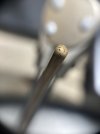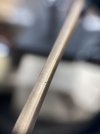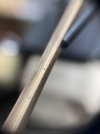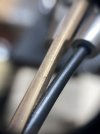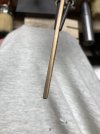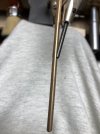Hello all, I am brand new to this forum and figured I'd create an account to see if any of the questions I can't find answers to through online research might be solved here!
I recently found a thread created by purplepepper8 about cracking caused when rolling out a gold ingot. My problem seems fairly similar other than I am rolling wire rather than sheet. From the replies in their thread I can only assume I am quenching slightly early when annealing. But from what I've found online it sounds like quenching when still red hot shouldn't be a problem.
I am heating my ingot/wire to a cherry red and quenching in water, then putting in the pickle. After the first annealing I don't see any problems but once I anneal a second time I start seeing hairline cracks that only grow larger as I continue to roll the wire out. I tried quenching once the metal turned black from red and experienced similar cracking so I am wondering if I might be doing something else that might cause the cracks(I also find them when I'm rolling out silver wire). The casting grain is from Hoover & Strong and they recommend an annealing temp of 1400˚ F; I've tried annealing both with a torch and setting a kiln to 1400˚ F and leaving the metal in for 10 minutes.
I'm also wondering how many times metals can be melted down and reworked before I should send it back to the refinery and get new material.
I'll attach a few photos of the cracks I am getting seen through a loupe and straight from my phone.
Any advice is greatly appreciated!
Thanks,
Monkegard
I recently found a thread created by purplepepper8 about cracking caused when rolling out a gold ingot. My problem seems fairly similar other than I am rolling wire rather than sheet. From the replies in their thread I can only assume I am quenching slightly early when annealing. But from what I've found online it sounds like quenching when still red hot shouldn't be a problem.
I am heating my ingot/wire to a cherry red and quenching in water, then putting in the pickle. After the first annealing I don't see any problems but once I anneal a second time I start seeing hairline cracks that only grow larger as I continue to roll the wire out. I tried quenching once the metal turned black from red and experienced similar cracking so I am wondering if I might be doing something else that might cause the cracks(I also find them when I'm rolling out silver wire). The casting grain is from Hoover & Strong and they recommend an annealing temp of 1400˚ F; I've tried annealing both with a torch and setting a kiln to 1400˚ F and leaving the metal in for 10 minutes.
I'm also wondering how many times metals can be melted down and reworked before I should send it back to the refinery and get new material.
I'll attach a few photos of the cracks I am getting seen through a loupe and straight from my phone.
Any advice is greatly appreciated!
Thanks,
Monkegard
Attachments
Last edited:


